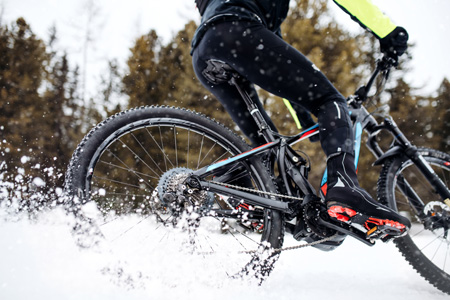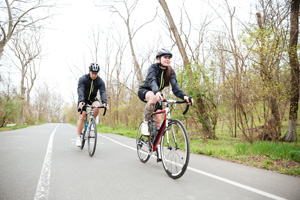
For some cyclists, winter means no more riding outside. When it starts to get cold they put aside their bikes and biking gear.
Others may start using their bike trainers to avoid boredom and maybe improve their skills.
However, there are determined bike riders who don’t let bad weather stop them.
The bone-chilling cold, wind, snow—why would anyone want to be outside cycling? Well, with the right clothes and gear, you will not have to worry about any of those things.
To someone who never cycles during winter, this may seem like torture. The bone-chilling cold, wind, snow—why would anyone want to be outside cycling? Well, with the right clothes and gear, you will not have to worry about any of those things.
This here is the ultimate guide to cycling during winter.
Key Takeaways
- Cycling during winter has many benefits such as boosting your immune system, burning more calories, exploring new places, and fighting winter blues.
- To cycle comfortably and safely in cold weather, you need to layer up properly with clothes and gear that are warm, breathable, waterproof, and visible.
- You can use your regular bike for winter cycling, but you need to make some adjustments such as using wider tires, lower pressure, bike lights, and fenders.
- You should also check your bike regularly, wash it after every ride, be prepared for punctures, and ride cautiously.
- Winter cycling can be an amazing experience if you are well-prepared and ready to enjoy the challenge.
Benefits of Cycling in the Winter: Why You Should Consider Winter Cycling
Being afraid of the cold is keeping you from enjoying a lot of benefits. Do you ever wonder why more cyclists are developing an interest in winter cycling?
Here is something you don’t know.
a. Winter Cycling Improves Your Immune System
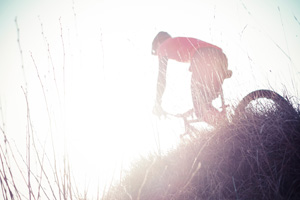
The immune system becomes slightly stronger when you are exposed to cold conditions.
This is according to a study published by the National Center for Biotechnology Information (NCBI). The study involved immersing young men in cold water for about one hour. This was done three times every week for six weeks.
The shivering caused an increase in their metabolic rate and, consequently, certain blood concentrates. To some extent, this strengthened the immune system.
b. You Burn More Calories
Cycling has always been great when it comes to burning calories. However, it is even better when you do it during winter. This is due to two things.
First of all, the cold temperatures may cause your metabolic rate to rise so your body can generate heat. Another thing, the cold will cause you to ride faster than usual to keep warm.
c. Avoid Weight Gain
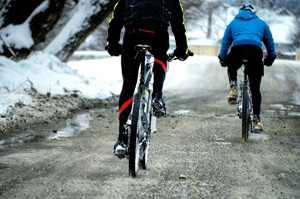
There are so many things to love about the holiday season. One of them is good food. It is a time to eat and enjoy the company of those you love.
While this is amazing, it comes with holiday weight-gain—yea, you know this is a thing. If you are lucky, you will gain less than 10 pounds.
Staying fit is important all year round. When the holiday is over, you don’t want to start going through the struggle of losing any extra weight.
d. Build Endurance
Bike riding during winter is not a walk in the park.
The cold will be biting through your body adding to the challenge of cycling through the snow and sometimes mud. The appropriate bike for such a condition is heavy. You also need to put on more clothes and have extra gear with you.
All these challenges make the exercise hard. At the end of the day, you not only build your muscles but also your endurance.
e. Enjoy Solitude and Peace
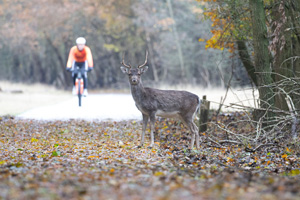
Maybe there are places you like to visit in your city but they are usually crowded. Winter is the best time to hop on your bike and visit them.
You can be sure to enjoy some much-needed solitude. Cycle around and see everything you have always wanted. Have fun alone, clear your mind and take good selfies for Instagram.
Even if you don’t already have a place in mind, the conditions will lead you to one. Your usual route may be impassable, forcing you to map out a new one. You will discover sceneries you never knew existed.
f. Brighter Mood
Winter blues can be a serious problem. This may sound like a myth but depression during winter is real. It is medically known as SAD (seasonal affective disorder). The condition is believed to be caused by little natural sunlight.
Physical exercise such as cycling boosts your mood by increasing endorphin levels. Other than that, you will expose yourself to light which will help with the condition.
Cycling in Winter: What to Wear
The most important thing is making sure you are properly dressed for the cold. You can only enjoy the above benefits if you are not focused on your freezing body. The secret is layering up properly.
1. Base Layer
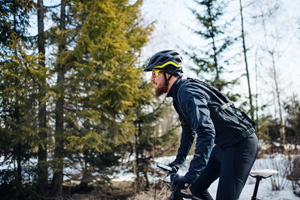
This is the first layer that is worn next to the skin.
As you cycle, you are likely to sweat. If this sweat stays on your skin, it causes cooling which is not good when the temperatures are already low. The base layer draws off swear before it causes the cooling.
Since this is something that sits on your skin, the material should be comfortable—soft and breathable. If you have the money, find one made from merino wool. If your budget is tight, polypropylene is nice too.
2. Bib tights
These can either be waist- or full- length. For winter, full-length bib tights are the best. They do the same thing as the base layer but for your legs.
There are bib tights for both men and women. Because of the cold, opt for those that are padded.
Some cyclists throw over trousers or baggy shorts over their tights. These are typically heavy-duty and waterproof.
3. Long-Sleeve Jersey
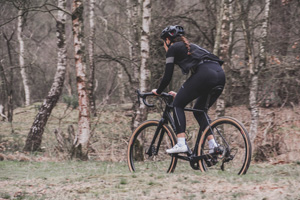
This is a mid-layer. You wear it over the base layer.
A jersey made specifically for cycling is easy to get. You may even have one already. Make sure it offers ventilation and can draw off sweat too.
It is important to get one that has pockets.
4. Jacket
You will need a softshell jacket and a waterproof jacket.
A softshell jacket offers insulation and warmth. Because of all the layers you will have on, find one that is flexible and breathable. You don’t want something that restricts movement and maximizes discomfort. Most of them are not completely waterproof so it may not be your topmost layer. However, choose a bright color for visibility just in case. Also, consider pockets.
You wear a waterproof jacket over the softshell or jersey. While all waterproof jackets protect you from the rain, they will leak at some point. Check the ranking of each jacket so you know what to expect. Understand that the more waterproof a jacket is, the less breathable it will be.
5. Skull Cap or Cycling Cap
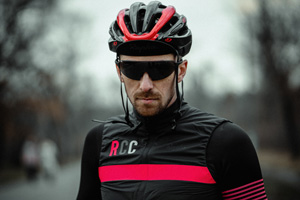
For your head, you can choose between a skull cap and a cycling cap.
Do you wear a helmet? Helmets are designed to offer some kind of cooling when it is hot. This is not a function you want when it is cold. To prevent your head from freezing, wear a skull cap underneath the helmet.
A cycling cap is ideal for people who prefer to ride without a helmet. Water- and wind-proof qualities are a must-have if you want to remain dry and warm. It should also extend to your ears.
6. Neck Warmer
Every part of your upper body is covered—except the neck. You cannot leave it exposed. For a neck cover, prioritize the material. Like the base layer, this is something that will be in contact with your skin the entire time.
When it gets too cold, you can always pull the cover over your mouth and nose for added warmth.
7. Overshoes, Winter Socks and Gloves
These are for your extremities.
Important qualities to look for include waterproof, windproof and insulation. If you will be using any touchscreen controls, get a glove with silicone fingertips.
For added warmth, get leg and arm warmers.
What Bike to Ride in the Winter
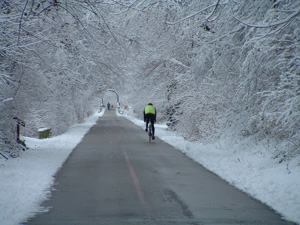
You can still use your usual bike for winter. It is alright if you cannot afford a winter bike.
As you can imagine, winter will be hard on your bike. Using your regular or best bike means that you have to make a few adjustments.
To make it ideal for winter:
a. Use wider tires. Find the widest winter tires that your machine can accommodate. If you expect to ride through ice, it is wise to get a studded brand.
b. Run tires at a lower-than-usual pressure. This not only enhances stability, but it also promotes grip.
c. Get bike lights. The brighter, the better. Days are typically shorter and sometimes you will have to ride in the dark. Besides, you want to be visible to other road users at all times.
d. Have fenders/mudguards. When spray gets on you, it won’t be pleasant. It draws heat from your body. The last thing you want is the feeling of something cold on your backside.
Winter Biking Tips for You
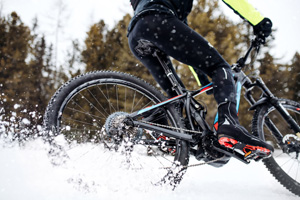
These tips are based on other people’s experiences. They made mistakes so you don’t have to.
1. Check your bike regularly. You probably do this even during the summer. However, it is even more important during winter and you need to be thorough. Examine the cables, chain, gears and other parts as often as you can. Look out for wear. Ensure that everything is in perfect condition.
2. Wash the bike after every ride. You will notice that it collects a lot of grime and all kinds of stuff. Wash it off to avoid accumulation.
3. Be prepared to fix your tires on the road. It would be great if you don’t have to deal with a puncture. But since you don’t know what will happen, prepare for it. Have a tube (or two) and a pump. For an easier life, you can buy tubeless tires.
4. Eat and hydrate. Cycling requires energy, especially during winter. Take a healthy breakfast and have a snack. While you may not feel thirsty, your body will still be losing water and hydration is crucial.
5. Ride safely and be cautious. Remember not to speed. In case of low visibility, you don’t want to unexpectedly run into something. Go slow and if you need to brake, do it early.
Conclusion
Riding your bike outside during winter can be an amazing experience. You get to spend time outside and catch some fresh air. If you get winter blues, then maybe going out will help with that. Becoming a 4-season cyclist will change your life for the better.
But first, you have to make sure you are warm and your bike is ready for the challenge. Be careful on the road and focus. Have a warm and fantastic experience.

